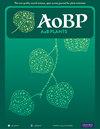Effect of life cycle and venation pattern on the coordination between stomatal and vein densities of herbs
IF 2.4
3区 生物学
Q2 ECOLOGY
引用次数: 0
Abstract
Background and Aims Life cycle (annual vs perennial) and leaf venation pattern (parallel and reticular) are known to be related to water use strategies in herb species and critical adaptation to certain climatic conditions. However, the effect of these two traits and how they influence the coordination between vein density (vein length per area, VLA) and stomatal density (SD) remains unclear. Methods In this study, we examined the leaves of 53 herb species from a subtropical botanical garden in Guangdong Province, China, including herbs with different life cycle and leaf venation pattern. We assessed 21 leaf water related functional traits for all species, including leaf area (LA), major and minor VLA, major and minor vein diameter (VD), SD, and stomatal length (SL). Key Results The results showed no significant differences in mean SD and SL between either functional group (parallel venation vs reticular venation and annual vs perennial). However, parallel vein herbs and perennial herbs displayed a significantly higher mean LA and minor VD, and lower minor VLA compared to reticular vein herbs and annual herbs, respectively. There was a linear correlation between total VLA and SD in perennial and reticular vein herbs, but this kind of correlation was not found in annual and parallel vein herbs. The major VLA and minor VD were significantly affected by the interaction between life cycle and leaf venation pattern. Conclusions Our findings suggested that VLA, rather than SD, may serve as a more adaptable structure regulated by herbaceous plants to support the coordination between leaf water supply and demand in the context of different life cycles and leaf venation patterns. The results of the present study provide mechanistic understandings of functional advantages of different leaf types, which may involve in species fitness in community assembly and divergent responses to climate changes.生命周期和叶脉模式对草本植物气孔密度和叶脉密度协调的影响
背景和目的 众所周知,生命周期(一年生与多年生)和叶脉模式(平行与网状)与草本植物的水分利用策略以及对特定气候条件的关键适应性有关。然而,这两个性状的作用以及它们如何影响叶脉密度(单位面积叶脉长度,VLA)和气孔密度(SD)之间的协调仍不清楚。方法 本研究考察了中国广东省亚热带植物园中 53 种草本植物的叶片,包括不同生命周期和叶脉形态的草本植物。我们评估了所有物种的 21 个叶片水分相关功能性状,包括叶面积(LA)、主要和次要叶脉直径(VLA)、主要和次要叶脉直径(VD)、SD 和气孔长度(SL)。主要结果 结果表明,两个功能组(平行脉与网状脉、一年生与多年生)之间的平均 SD 和 SL 没有明显差异。然而,与网状脉草本植物和一年生草本植物相比,平行脉草本植物和多年生草本植物的平均 LA 和小 VD 明显较高,而小 VLA 则较低。在多年生草本植物和网脉草本植物中,总VLA与SD之间存在线性相关,但在一年生草本植物和平行脉草本植物中没有发现这种相关性。生命周期与叶脉形态的交互作用对主要 VLA 和次要 VD 有显著影响。结论 我们的研究结果表明,在不同生命周期和叶脉模式下,VLA 而非 SD 可能是草本植物调节叶片水分供需平衡的一个适应性更强的结构。本研究的结果提供了对不同叶片类型功能优势的机理认识,这些优势可能涉及物种在群落组合中的适应性以及对气候变化的不同反应。
本文章由计算机程序翻译,如有差异,请以英文原文为准。
求助全文
约1分钟内获得全文
求助全文
来源期刊

AoB Plants
PLANT SCIENCES-
CiteScore
4.80
自引率
0.00%
发文量
54
审稿时长
20 weeks
期刊介绍:
AoB PLANTS is an open-access, online journal that has been publishing peer-reviewed articles since 2010, with an emphasis on all aspects of environmental and evolutionary plant biology. Published by Oxford University Press, this journal is dedicated to rapid publication of research articles, reviews, commentaries and short communications. The taxonomic scope of the journal spans the full gamut of vascular and non-vascular plants, as well as other taxa that impact these organisms. AoB PLANTS provides a fast-track pathway for publishing high-quality research in an open-access environment, where papers are available online to anyone, anywhere free of charge.
 求助内容:
求助内容: 应助结果提醒方式:
应助结果提醒方式:


